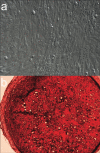Concepts for the clinical use of stem cells in equine medicine
- PMID: 19119371
- PMCID: PMC2553494
Concepts for the clinical use of stem cells in equine medicine
Abstract
Stem cells from various tissues hold great promise for their therapeutic use in horses, but so far efficacy or proof-of-principle has not been established. The basic characteristics and properties of various equine stem cells remain largely unknown, despite their increasingly widespread experimental and empirical commercial use. A better understanding of equine stem cell biology and concepts is needed in order to develop and evaluate rational clinical applications in the horse. Controlled, well-designed studies of the basic biologic characteristics and properties of these cells are needed to move this new equine research field forward. Stem cell research in the horse has exciting equine specific and comparative perspectives that will most likely benefit the health of horses and, potentially, humans.
Concepts pour l’utilisation clinique des cellules souches en médecine équine. Les cellules souches provenant de différents tissus suscitent de grands espoirs en thérapeutique équine mais jusqu’à maintenant la preuve de leur efficacité ou le principe même de leur utilité n’a pas été établi. Les caractéristiques de base et les propriétés des diverses cellules souches équines demeurent largement inconnues en dépit d’une augmentation des indications expérimentales et d’une utilisation commerciale empirique. Une meilleure compréhension de la biologie des cellules souches équines et des concepts impliqués est nécessaire pour développer et évaluer des applications cliniques rationnelles chez le cheval. Des études contrôlées et bien planifiées sur les caractéristiques et les propriétés biologiques de base de ces cellules sont nécessaires pour faire évoluer ce nouveau champ de recherche. La recherche sur les cellules souches du cheval ouvre des perspectives enlevantes tant pour l’espèce équine que pour la médecine comparative. Ces avancées pourront vraisemblablement améliorer la santé équine et, potentiellement, la santé humaine.
(Traduit par Docteur André Blouin)
Figures





Similar articles
-
Current and future regenerative medicine - principles, concepts, and therapeutic use of stem cell therapy and tissue engineering in equine medicine.Can Vet J. 2009 Feb;50(2):155-65. Can Vet J. 2009. PMID: 19412395 Free PMC article. Review.
-
Depressing time: Waiting, melancholia, and the psychoanalytic practice of care.In: Kirtsoglou E, Simpson B, editors. The Time of Anthropology: Studies of Contemporary Chronopolitics. Abingdon: Routledge; 2020. Chapter 5. In: Kirtsoglou E, Simpson B, editors. The Time of Anthropology: Studies of Contemporary Chronopolitics. Abingdon: Routledge; 2020. Chapter 5. PMID: 36137063 Free Books & Documents. Review.
-
Qualitative evidence synthesis informing our understanding of people's perceptions and experiences of targeted digital communication.Cochrane Database Syst Rev. 2019 Oct 23;10(10):ED000141. doi: 10.1002/14651858.ED000141. Cochrane Database Syst Rev. 2019. PMID: 31643081 Free PMC article.
-
Trends in Surgical and Nonsurgical Aesthetic Procedures: A 14-Year Analysis of the International Society of Aesthetic Plastic Surgery-ISAPS.Aesthetic Plast Surg. 2024 Oct;48(20):4217-4227. doi: 10.1007/s00266-024-04260-2. Epub 2024 Aug 5. Aesthetic Plast Surg. 2024. PMID: 39103642 Review.
-
Unlocking data: Decision-maker perspectives on cross-sectoral data sharing and linkage as part of a whole-systems approach to public health policy and practice.Public Health Res (Southampt). 2024 Nov 20:1-30. doi: 10.3310/KYTW2173. Online ahead of print. Public Health Res (Southampt). 2024. PMID: 39582242
Cited by
-
GAPDH, β-actin and β2-microglobulin, as three common reference genes, are not reliable for gene expression studies in equine adipose- and marrow-derived mesenchymal stem cells.J Anim Sci Technol. 2015 May 7;57:18. doi: 10.1186/s40781-015-0050-8. eCollection 2015. J Anim Sci Technol. 2015. PMID: 26290738 Free PMC article.
-
International Survey Regarding the Use of Rehabilitation Modalities in Horses.Front Vet Sci. 2018 Jun 11;5:120. doi: 10.3389/fvets.2018.00120. eCollection 2018. Front Vet Sci. 2018. PMID: 29942811 Free PMC article.
-
Phenotypic and immunomodulatory properties of equine cord blood-derived mesenchymal stromal cells.PLoS One. 2015 Apr 22;10(4):e0122954. doi: 10.1371/journal.pone.0122954. eCollection 2015. PLoS One. 2015. PMID: 25902064 Free PMC article.
-
Culture conditions for equine bone marrow mesenchymal stem cells and expression of key transcription factors during their differentiation into osteoblasts.J Anim Sci Biotechnol. 2013 Oct 29;4(1):40. doi: 10.1186/2049-1891-4-40. J Anim Sci Biotechnol. 2013. PMID: 24169030 Free PMC article.
-
Current and future regenerative medicine - principles, concepts, and therapeutic use of stem cell therapy and tissue engineering in equine medicine.Can Vet J. 2009 Feb;50(2):155-65. Can Vet J. 2009. PMID: 19412395 Free PMC article. Review.
References
-
- Thomson JA, Itskovitz-Eldor J, Shapiro SS, et al. Embryonic stem cell lines derived from human blastocysts. Science. 1998;282:1145–1147. - PubMed
-
- Evans MJ, Kaufman MH. Establishment in culture of pluripotential cells from mouse embryos. Nature. 1981;292:154–156. - PubMed
-
- Li X, Zhou SG, Imreh MP, Ahrlund-Richter L, Allen WR. Horse embryonic stem cell lines from the proliferation of inner cell mass cells. Stem Cells Dev. 2006;15:523–531. - PubMed
-
- Saito S, Sawai K, Minamihashi A, Ugai H, Murata T, Yokoyama KK. Derivation, maintenance, and induction of the differentiation in vitro of equine embryonic stem cells. Methods Mol Biol. 2006;329:59–79. - PubMed
Publication types
MeSH terms
LinkOut - more resources
Full Text Sources
Other Literature Sources
Medical
